|
May 18, 2017
Injured Workers Demand Canadian
Standard Compensation
"We Are Working on a Provincial Campaign
to Reform the Compensation System to Fulfill Its Mandate"
- Karl Crevar, Ontario Representative,
Canadian Injured Workers' Alliance -
PDF
All Out
for Ontario Injured Workers' Day June 1!
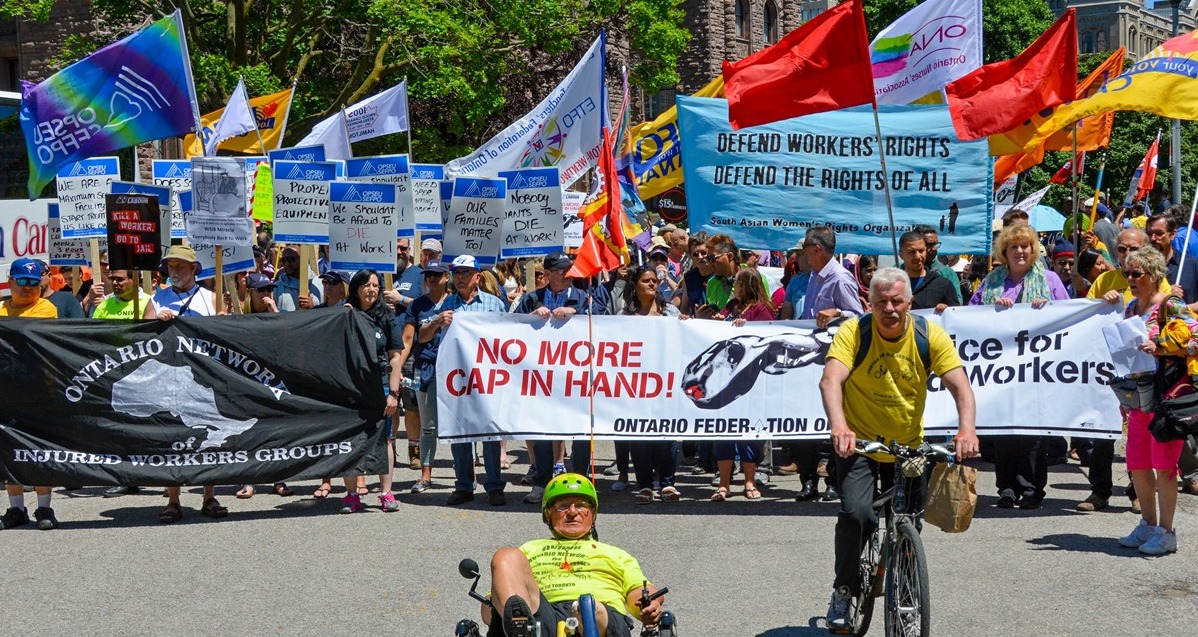
Justice
Bike
Ride
Rights for
All!
Thursday, May 25 -- Thursday, June 1
Starts in Ottawa and visits Cornwall, Brockville, Kingston,
Belleville, Cobourg, Oshawa, arriving in Toronto for Queen's Park Rally
For itinerary see
here
Vigil
Sleepless in
Queen's Park
Wednesday, May 31 -- 7:00 pm
Queen's Park, Toronto
Facebook
Rally & March
Workers'
Compensation Is a Right!
Thursday, June 1 -- 11:30 am - 1:00 pm
Queen's Park, Toronto
Facebook
Panel
Discussion
Fighting Back Against Toxic and Unsafe
Work
Thursday, June 1 -- 2:00 pm
OCAD Auditorium, 100 McCaul St. Room 190, Toronto
Facebook
Organized
by
Ontario
Network
of
Injured
Workers
Groups
|
|
Injured
Workers
Demand
Canadian
Standard
Compensation
• "We Are Working on a Provincial Campaign to
Reform the Compensation
System to Fulfill Its Mandate" - Karl Crevar, Ontario
Representative,
Canadian Injured Workers' Alliance
• "We Want to Restore Balance at WorkSafe New
Brunswick" - Patrick Colford, President, New Brunswick
Federation of Labour
Canadians'
Need
for
Their
Own
Steel
Industry
• New Class-Action Lawsuits Against U.S. Steel
• U.S. Steel Faces Historic Necessity for
Change - K.C. Adams
Consequences of Trade
War in Forestry Industry
• Resolute Forest Products Lays Off Workers
• Softwood Lumber Prices Rise Sharply in Canada
Injured Workers Demand Canadian Standard
Compensation
"We Are Working on a Provincial Campaign to
Reform the
Compensation System
to Fulfill Its Mandate"
- Karl Crevar, Ontario Representative,
Canadian Injured Workers' Alliance -
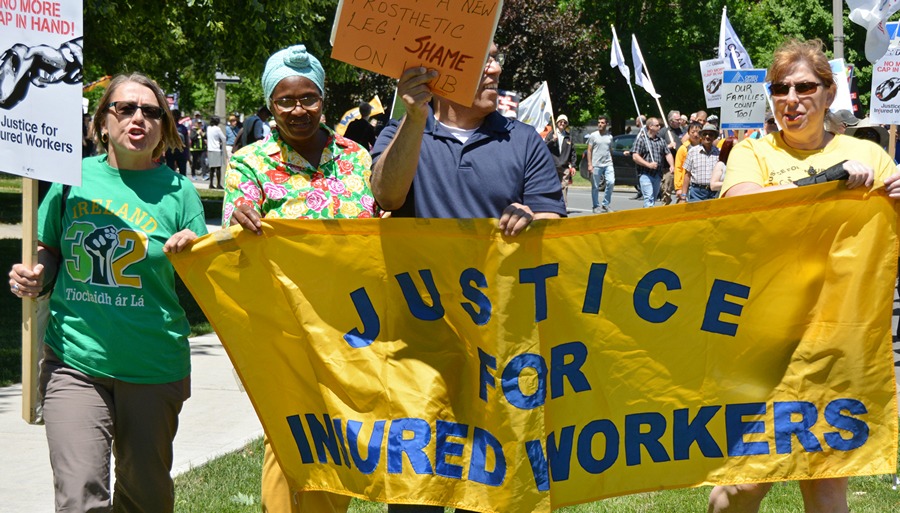 Workers' Forum:
What
are
the
main
issues
facing
injured
workers
at
this
time? Workers' Forum:
What
are
the
main
issues
facing
injured
workers
at
this
time?
Karl Crevar: What we find in
our work is that there are common problems going on right across Canada
such as the treatment of pre-existing conditions. Some of the
legislation is also very similar. Even on the health and safety issues,
the numbers of workplace fatalities are similar and they are on the
rise.
We have a court case that is going on in regard to
Non-Economic Loss (NEL) awards. We went to court to see if workers can
proceed and the Supreme Court said yes, we can proceed. There are a
number of people whose NEL has been reduced because of existing
legislation on pre-existing conditions. A NEL award happens when you
have a permanent impairment. They were introduced to replace full
lifetime pensions back in 1990. Before that, if you had a permanent
impairment you could be awarded a lifetime pension. Now, if you have a
permanent impairment, you are only going to be assessed up to age
sixty-five. Pre-existing conditions considered in adjudicating claims
are being used widely all over the country to reduce injured workers'
benefits.
Then there is the issue of the workers' doctors. A
number of doctors came out publicly two years ago because their
decisions were being overturned by Ontario's Workplace Safety and
Insurance Board (WSIB). A number of complaints have been filed with the
Ontario
Ombudsman. Professional medical opinions are being overturned by
workers' compensation
boards across the country, which are using medical consultants to
override the opinion of the workers' physicians.
The Ontario Network of Injured Workers' Groups, of
which I am a member of the Board of Directors, also obtained intervenor
status in the Supreme Court of Canada in a case out of Quebec regarding
the human right of an injured worker to an accommodation with suitable
duties when the worker exercises their right to return to work. We
were part of that case because we are concerned that a Supreme Court
decision could have an impact not only in Quebec or Ontario but right
across Canada.
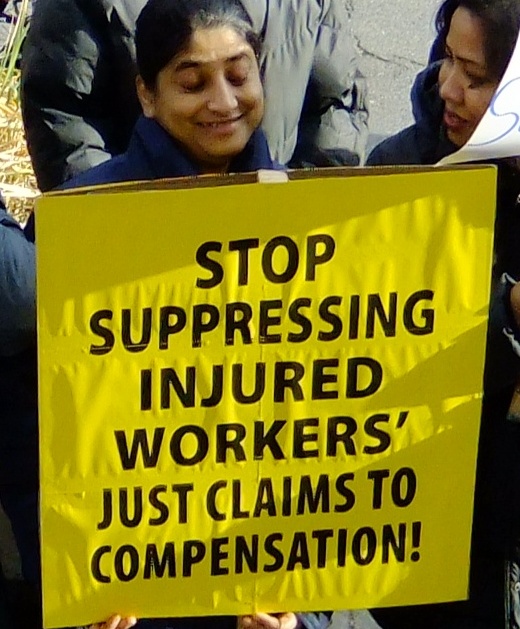 Generally what is happening
is a push for financial stability of the system. Compensation boards
are trying to get rid of their unfunded liabilities, particularly in
Ontario where for the last seven years there has been a strict focus on
unfunded liability. The government and the WSIB have developed policies
to more strongly enforce the issue of pre-existing conditions in order
to reduce NEL awards. What it has
actually done is increase the number of cases that are going to the
Workplace Safety and Insurance Appeals Tribunal. People are rejecting
the decisions of the Board and there are approximately four to five
thousand claims sitting or waiting to be adjudicated just in Ontario.
Workers have to wait anywhere from two to five years and I suspect that
the same thing is happening across Canada. The Ontario government and
the Board are addressing the issue of unfunded liability, but who is
paying for it? It is the injured workers. It is not true that the
system has to be 100 per cent funded in order to pay the cost of
the future claims if the Board and the government were willing to raise
the assessment rates, which they are not doing. In spite of the
increase
of cases that are being denied and going to the tribunal and the cuts
we have been seeing in the NEL because of pre-existing conditions, the
Board in Ontario reduced assessment rates for the
year 2017. Generally what is happening
is a push for financial stability of the system. Compensation boards
are trying to get rid of their unfunded liabilities, particularly in
Ontario where for the last seven years there has been a strict focus on
unfunded liability. The government and the WSIB have developed policies
to more strongly enforce the issue of pre-existing conditions in order
to reduce NEL awards. What it has
actually done is increase the number of cases that are going to the
Workplace Safety and Insurance Appeals Tribunal. People are rejecting
the decisions of the Board and there are approximately four to five
thousand claims sitting or waiting to be adjudicated just in Ontario.
Workers have to wait anywhere from two to five years and I suspect that
the same thing is happening across Canada. The Ontario government and
the Board are addressing the issue of unfunded liability, but who is
paying for it? It is the injured workers. It is not true that the
system has to be 100 per cent funded in order to pay the cost of
the future claims if the Board and the government were willing to raise
the assessment rates, which they are not doing. In spite of the
increase
of cases that are being denied and going to the tribunal and the cuts
we have been seeing in the NEL because of pre-existing conditions, the
Board in Ontario reduced assessment rates for the
year 2017.
As more and more workers' claims are being denied they
are forced to go to other social services such as social assistance.
Governments are downloading costs onto communities, onto the taxpayers,
which is not the way the workers' compensation legislation originally
was. The employers were to pay the assessments to fund the program, not
the taxpayers or the injured workers. We are raising this in the
communities, particularly with our Bike Ride that is going on from May
25 to June 1. We are opposing the downloading of the costs of the
compensation system from the employers onto the communities and the
taxpayers.
Another big issue of concern is the fact that there is
a trend, especially in the U.S., for employers to be able to opt out of
the compensation system. This has already happened in a few states in
the U.S. and this means that the employers are managing their
compensation, their injuries. This is self-regulation and it is an
alarming trend that we
are witnessing.
In Ontario, we are also working on a provincial
campaign, with our labour and community partners, to reform the
compensation system so that it fulfills its mandate as was set by the Workplace Safety and Insurance
Act. This is going to be a real challenge not only to the Board
but to
the next government.
Ontario elections are coming in 2018 and we want
this reform of the compensation system to be part of the platform of
the parties that are going to run to form the government. Poverty of
injured workers has gone up, family breakups have gone up, all these
things are on the rise. We are going to make these issues election
issues.

"We Want to Restore Balance at
WorkSafe New Brunswick"
- Patrick Colford, President, New
Brunswick Federation of Labour -
Workers' Forum: The government of New
Brunswick announced at the beginning of May that it will establish a
task force to examine WorkSafe, the workers' compensation in New
Brunswick. What is the stand of the Federation of Labour on this move
by the government?
Patrick Colford: Certainly, if
this is the direction that the government wants to go with the task
force, the New Brunswick Federation of Labour, the largest labour body
in the province, should be at the table. We are also asking for the
public to
talk to their MLAs about WorkSafe. We want the public to ask questions.
We
have been calling for a while for assessment rates to be increased,
because the WorkSafe Board told us that by 2017 the fund may be in
a deficit position. Over the last six years the average rate has
declined from $2.08 per $100 of payroll in 2010
to $1.11 in 2016.
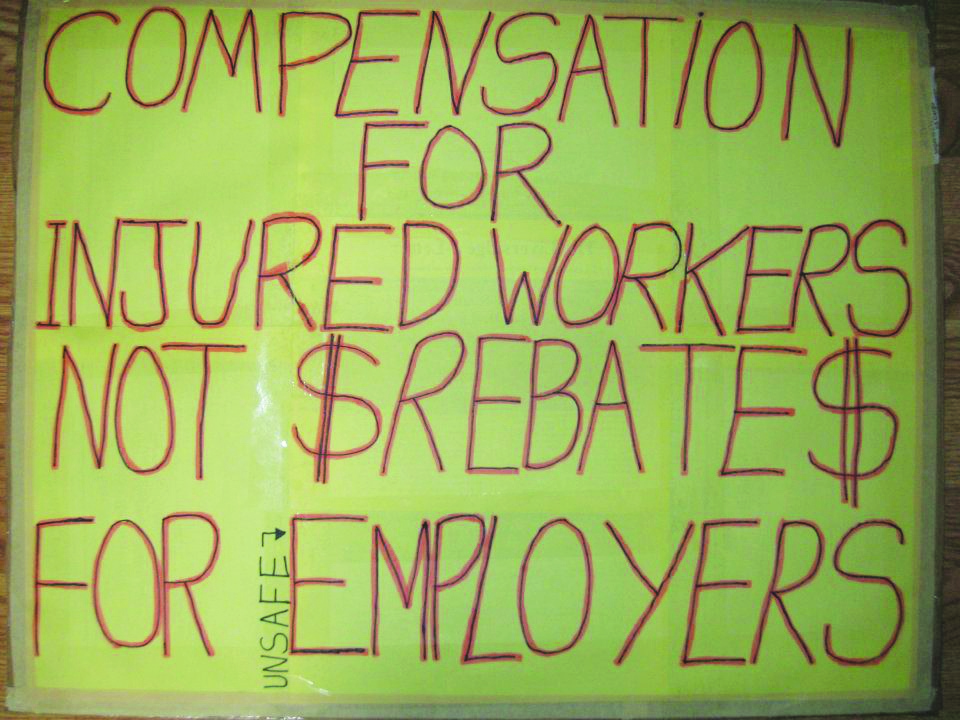 We are a little bit worried
with that because last time that it was in a deficit position, in the
early 1990s, workers gave up a lot of benefits and a lot of
clawbacks were introduced. That is when New Brunswick introduced the
three-day waiting period, when we went from 90 per cent wage
recovery back to 80 per cent, as
well as a whole host of clawbacks. It was presented at the time that we
were going to do this until the system got back to being funded
at 110 per cent as that is where the comfort zone is. We have seen
the system funded as high as 130 per cent and actually in the last
two years, since 2015-2016, when the system was in that
surplus range, rebates were given back to the employers. In the last
three years employers have received rebates of up to $51 million
and workers' benefits have not increased. There has been some increase
of the assessment rates for 2017 and the employers' side is crying
foul, saying they can't afford assessment rates to go up
otherwise benefits will have to shut down. This is the same rhetoric we
hear all the time. We even have some of the biggest employers'
representatives saying that WorkSafe should be run by a private
insurance firm. We are a little bit worried
with that because last time that it was in a deficit position, in the
early 1990s, workers gave up a lot of benefits and a lot of
clawbacks were introduced. That is when New Brunswick introduced the
three-day waiting period, when we went from 90 per cent wage
recovery back to 80 per cent, as
well as a whole host of clawbacks. It was presented at the time that we
were going to do this until the system got back to being funded
at 110 per cent as that is where the comfort zone is. We have seen
the system funded as high as 130 per cent and actually in the last
two years, since 2015-2016, when the system was in that
surplus range, rebates were given back to the employers. In the last
three years employers have received rebates of up to $51 million
and workers' benefits have not increased. There has been some increase
of the assessment rates for 2017 and the employers' side is crying
foul, saying they can't afford assessment rates to go up
otherwise benefits will have to shut down. This is the same rhetoric we
hear all the time. We even have some of the biggest employers'
representatives saying that WorkSafe should be run by a private
insurance firm.
We hope this task force won't result in more cuts to
the benefits of injured workers. Our main concern is restoring the
balance at WorkSafe New Brunswick, getting rid of that three-day
waiting period. In the province of New Brunswick if you get hurt at
work and need to file a claim you have three days without pay before
you file your
claim. That is three days of lost wages. The other aspect is the wage
recovery. A lot of my members have a hard time living on 100 per
cent of their wages so to be penalized for being injured at work does
not make sense. Injuries are not being reported because workers say
that they will work with their injuries because they cannot afford
that three-day waiting period and the lost wages. People are working
injured and suffering even greater harm because their injuries do not
have time to heal.
The New Brunswick Federation of Labour is holding its
Biennial Convention May 28-May 31 and we are going to be
launching our WorkSafe campaign at the convention.

Canadians' Need for Their Own Steel
Industry
New Class-Action Lawsuits Against U.S. Steel
Numerous class-action lawsuits were launched against
U.S. Steel at the beginning of May, accusing the company of misleading
shareholders and buyers of USS stocks. According to press releases,
lawsuits have been filed on behalf of U.S. Steel investors by Robbins
Arroyo LLP, Lundin Law PC, Khang and Khang LLP, Kessler Topaz Meltzer
and Check, LLP, Rosen Law Firm, Johnson and Weaver LLP, Goldberg Law PC
and others.
Excerpts from two of the legal firms' press releases
explain the nature of the complaint. In a news release on May 9,
Robbins Arroyo LLP said:
"Shareholder rights law firm Robbins Arroyo LLP
announces that a class action complaint was filed against United States
Steel Corporation (NYSE: X) in the U.S. District Court for the Western
District of Pennsylvania. The complaint is brought on behalf of all
purchasers of U.S. Steel securities between November 1, 2016
and
April 25, 2017, for alleged violations of the Securities
Exchange Act of 1934 by U.S. Steel's officers and
directors. U.S.
Steel produces and sells flat-rolled and tubular steel products
primarily in North America and Europe.
"According to the complaint, in 2013, U.S. Steel
launched a process called the 'Carnegie Way,' which was a business
strategy designed to create stockholder value. In the
company's 2016 Form 10-K filed with the U.S. Securities and
Exchange Commission on February 28, 2017, U.S. Steel stated
that '[t]he
Carnegie Way has already driven a shift in the Company that has enabled
us to withstand the prolonged downturn in steel prices while
positioning us for success in a market recovery.' However, on
April 25, 2017, U.S. Steel reported a net loss of $180
million, or negative $1.03 per diluted share, and a negative
operating
cash flow of $135 million. The company further revealed a
reduced 2017 outlook that widely missed analyst expectations,
including a 35 per cent reduction to its 2017 adjusted
earnings
guidance before interest, tax, depreciation, and amortization. During a
conference call on April 26, 2017, U.S. Steel's Chief
Executive Officer, Mario Longhi, stated that the company would 'be
taking more downtime at our facilities, which will limit our steel
production volumes.' On this news, U.S. Steel's stock fell 26 per
cent to close at $22.78 per share on April 26, 2017...."
On May 9, Lundin Law PC announced a suit concerning the
same period. It stated:
"According to the Complaint, during the Class Period,
U.S. Steel issued materially false and/or misleading statements and/or
failed to disclose: that while the Company was implementing its
Carnegie Way program, it was focused on cutting costs and was not
making investments necessary to position U.S. Steel so that it could
respond to
improved market conditions; that the Company's failure to invest in
improving capital assets during the industry downturn, in order to
report apparent financial improvements, meant that U.S. Steel had
higher production costs than its competitors, even in the face of
improved pricing, which would negatively impact its financial results;
and that
U.S. Steel was forestalling expensive capital equipment upgrades in
order to boost its short-term financial results at the expense of
long-term financial performance, leaving U.S. Steel in need of
accelerated, costly equipment upgrades that would leave the Company
years away from generating improved financial performance. When this
news was
released, U.S. Steel's stock price declined materially, which harmed
investors according to the Complaint."

U.S. Steel Faces Historic Necessity for Change
- K.C. Adams -
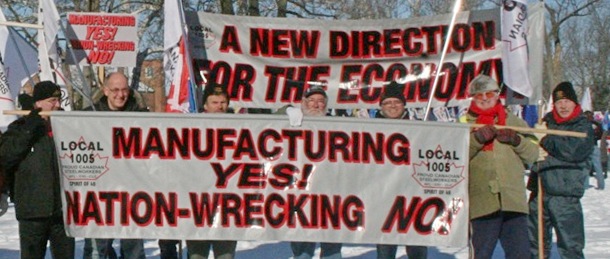
Ruling oligarchy blocks resolution of
economic problems and
continues
on failed path
U.S. Steel considers the amount it does not spend on
renewing its productive force as savings. The quantified savings
year upon year since 2014 is $2.5 billion. It reports that
the company "has realized from CEO Mario Longhi's Carnegie Way
efficiency and cost-cutting initiative $575 million
in 2014; $815 million in 2015; $745 million
in 2016; and $310 million so far this year."
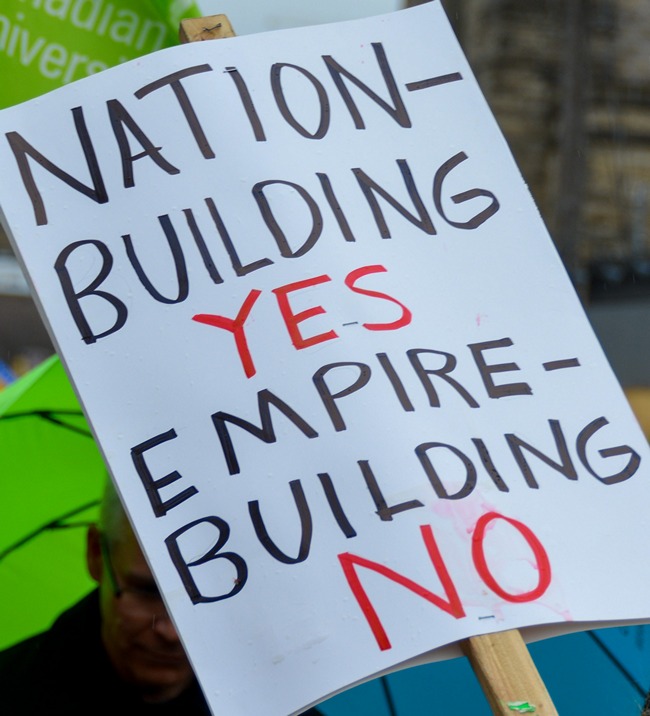
The result, in the words of USS, is "enormously more
efficient operations." This factor coupled with rising steel market
prices should result in "enormously" improved financial results. Why
then, did U.S. Steel report a $180 million first-quarter loss and
slash its 2017 profit outlook in half? Simply put, the Carnegie
Way and other
forms of refusal to renew productive capacity such as closing perfectly
good mills are examples of the ruling oligarchy's unwillingness to face
the historic necessity for a new direction in the economy.
The present relations of production whereby the actual
producers are not in control of the socialized forces of production
doom the economy to failure. Private control of socialized production
cannot take advantage of or control the production and distribution of
the enormous social product. The aim of private ownership to compete
globally
for profit and empire-building with other privately owned parts of the
economy is in contradiction with the objective conditions of modern
socialized production.
Socialized production demands broad cooperation of all
parts and sectors of the economy in a nation-building project to
guarantee the well-being of the people and general interests of society
that opens a path towards the emancipation of the working class. The
modern working class is the only social force with the aim and outlook
to manage
the socialized means of industrial mass production for the benefit of
all, in harmony with all its interrelated parts without crises. The
working class as the actual producers has the aim and duty to
distribute the social product within a nation-building project that
guarantees extended reproduction of the economy and the well-being,
security and rights
of all.
U.S. Steel and Its Years of Failure
U.S. Steel executives and private institutional
ownership of its stock equity and debt refuse to recognize and accept
the law of a falling rate of profit in industrial mass production
caused by the ever-increasing amount of social wealth required in
modern productive forces. To counter the law, the ruling financial
oligarchy engages in reckless
parasitic adventures
including predatory and inter-imperialist wars with competitors and
lashes out at the
working class and productive forces in destructive anger.
USS has made equity profit in only one year
-- $102 million in 2014 -- since 2008. Why then have all
the "cost savings" from closing and abandoning facilities in Canada and
elsewhere, refusing to invest in renewing production, and forcing
concessions from steelworkers and salaried employees not resulted in
profits?
Where is the much-ballyhooed $2.5 billion in cost savings from the
Carnegie Way? This puzzle confounds financial analysts and
representatives of the institutional owners of the company's stock
equity and debt who are impatient for positive answers and results and
do not appreciate continuing losses. The experts, journalists and
university
pundits are all schooled in seeing only what the ruling imperialist
class wants them to see. They are not good at engaging in acts of
finding out what the root problems really are in the socialized economy.
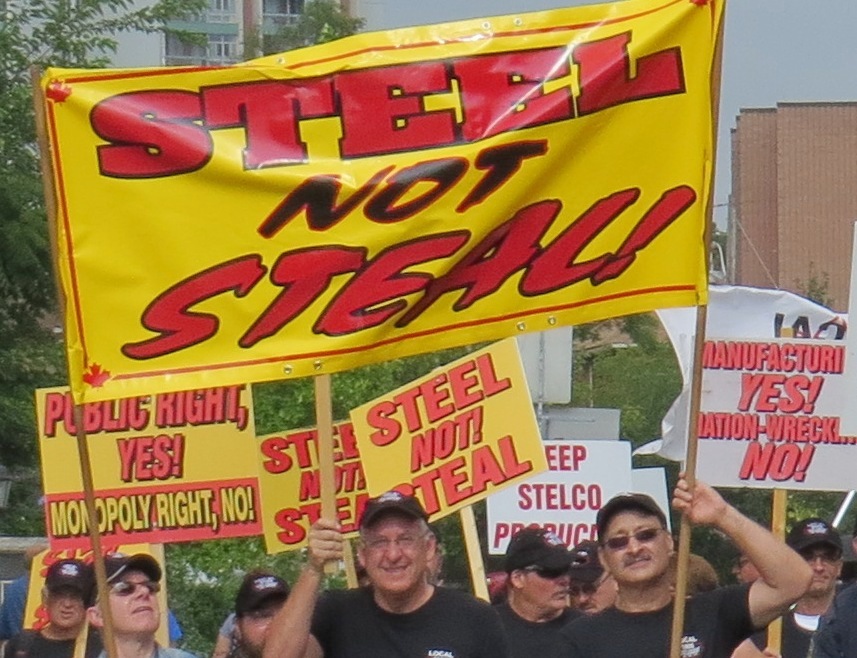 Len Boselovic of the Pittsburgh
Post-Gazette
writes, "The miserable performance makes U.S.
Steel's constant contention that the company can compete with anybody
if only Washington would crack down on predatory, subsidized imports
look pretty ridiculous." He quotes Axiom Capital analyst Gordon Johnson
saying, "They (USS)
can't compete with anybody on a level playing field. They have the
highest costs in the industry." Len Boselovic of the Pittsburgh
Post-Gazette
writes, "The miserable performance makes U.S.
Steel's constant contention that the company can compete with anybody
if only Washington would crack down on predatory, subsidized imports
look pretty ridiculous." He quotes Axiom Capital analyst Gordon Johnson
saying, "They (USS)
can't compete with anybody on a level playing field. They have the
highest costs in the industry."
Boselovic writes, "In announcing the
company's $440 million loss last year, Mr. Longhi emphasized that
'Carnegie Way transformation efforts' have improved the company's cost
structure. 'These substantive changes and improvements have increased
our earnings power'."
Really, Mr. Longhi, why then is USS facing another huge
quarterly loss and projected losses for years to come?
New York economic analyst Charles Bradford was not
convinced and looking for the promised improved earnings in U.S.
Steel's first-quarter numbers asked rhetorically during the company's
quarterly conference call, "Where is it?"
"Oh, it's there," replied a U.S. Steel spokesperson.
"The company completed nearly 450 Carnegie Way projects in the
first quarter and has over 3,500 more in the pipeline."
Boselovic writes, "Such pronouncements make skeptics
think the critical elements of the Carnegie Way are smoke and
mirrors.... [Axiom Capital analyst Johnson] believes the problem is
that for years, U.S. Steel has spent less on capital expenditures to
modernize its mills than it has reported in depreciation and
amortization expenses -- an accounting measure that expenses the cost
of the company's steelmaking equipment over its useful life and
measures how much book value the equipment loses each year.
"When depreciation and amortization exceed capital
expenditures, it is a strong indication that a company is not investing
enough to keep its plant and equipment up to date. 'This is a company
that has under maintained its facilities for 80 years,' Mr.
Bradford said."
Mr. Bradford could investigate who has claimed the
added-value steelworkers have produced over the years. Added-value has
been available for reinvestment in the productive forces if the owners
of debt and others would reduce their claims and graciously accept a
fall in the rate of profit. But that is not in their class nature.
Owners of stock equity have routinely claimed twenty
cents per share annually for years, around $34.8 million, on
greatly fluctuating stock ownership equity of $3.5 billion.
Executives have doled out this amount even while announcing continuous
quarterly losses per share.
The lion's share of the annual claim on added-value
goes to owners of debt, which amounts to about $230 million
on $3.4 billion of debt ownership. Other claimants on added-value
include executive managers and governments.
 The totality and pressure
for claims on added-value go beyond what is available and often dips
into transferred-value that should be used to replace depreciated
machinery or pay for material inputs. Ironically, the subjective
feature of the imperialist controlled economy with private ownership's
insistence on an ever-greater return on its
investment of social wealth despite the objective law of a falling rate
of profit puts pressure on executive managers not to reinvest in
production from added-value but instead use additional borrowing, which
exacerbates the problem and leads to greater crises. The totality and pressure
for claims on added-value go beyond what is available and often dips
into transferred-value that should be used to replace depreciated
machinery or pay for material inputs. Ironically, the subjective
feature of the imperialist controlled economy with private ownership's
insistence on an ever-greater return on its
investment of social wealth despite the objective law of a falling rate
of profit puts pressure on executive managers not to reinvest in
production from added-value but instead use additional borrowing, which
exacerbates the problem and leads to greater crises.
In large industrial companies requiring huge
investments of social wealth in the means of production, the oligarchs
prefer debt ownership for its regular claims, and stock equity
ownership for a chance to manipulate the fluctuating stock price to
their advantage and fleece other buyers of stock. Many industrial
companies pay no stock dividend
at all but must service the debt ownership with interest profit or go
into bankruptcy protection.
Len Boselovic continues, "[Johnson] has been listening
to the company's pronouncement about being able to compete on a level
playing field for decades and isn't buying it. 'This is the same
garbage story we heard in the '70s when [former chair of USS] David
Roderick claimed they could compete with anybody,' he said.... If Mr.
Longhi
had paid more attention to his mills instead of government handouts,
'Maybe things would have been a little different,' Mr. Johnson said."
Forbes, a major news agency of the financial
oligarchy, tried to explain the situation in an item entitled,
"Underperforming
Amid Favorable Business Conditions: The Curious Case Of U.S. Steel."
The explanation looks only at the obvious surface features and fails to
probe deeply into why such problems continually plague not
only particular companies but entire sectors and the socialized economy
captured within the private control of the oligarchs.
The Forbes article states, "U.S. Steel dismayed
investors with an underwhelming Q1 earnings release last week. The
company reported an unexpectedly steep decline in shipments for its
U.S. Flat-Rolled steelmaking operations, which account for
around 70 per cent of the company's revenue, translating into a
significant decline
in EPS (Earnings Per Share). The poor Q1 2017 earnings resulted in
a sharp decline in the company's stock price over the course of the
past week.... The company attributed the decline in shipments for the
Flat-Rolled division to planned production outages as it embarks upon
its asset revitalization program, which is aimed at improving the
efficiency, reliability, and product quality in addition to lowering
production costs. However, in doing so, the company is foregoing higher
production levels during a favorable time period characterized by
rising steel prices and demand for the commodity in key markets.
"The improved business conditions are reflected in the
recent recovery in steel prices, with U.S. Steel reporting an 18
per cent year-over-year increase in realized prices for the Flat-Rolled
division in Q1.... In Q3 2016, the division's shipments were
negatively impacted to the tune of 125,000 tons, or around 5
per cent
of the company's Q3 shipments, as a result of unplanned production
outages. The division's shipments fell further 6 per cent
sequentially in Q4, as a result of planned production outages. The
company lowered production levels in Q4 as it undertook its asset
revitalization process, partly aimed at addressing operational problems
leading to
unplanned production outages. However, problems for the company's
Flat-Rolled steelmaking operations continued into 2017, with the
accidental release of waste water from the company's Midwest plant in
Portage, Indiana, which temporarily halted operations at the plant.
Moreover, the company reported a 4 per cent year-over-year
decline in shipments for its Flat-Rolled division in Q1 2017, with
the decline in shipments attributed to planned production outages under
the asset revitalization program.
 "The recent disruptions at
the Flat-Rolled steel division's facilities have raised concerns over
U.S. Steel's ability to increase production levels to profit from the
improved business conditions for steel in the U.S. The asset
revitalization program will lower the Flat-Rolled division's shipments
by around 1 million tons in 2017." "The recent disruptions at
the Flat-Rolled steel division's facilities have raised concerns over
U.S. Steel's ability to increase production levels to profit from the
improved business conditions for steel in the U.S. The asset
revitalization program will lower the Flat-Rolled division's shipments
by around 1 million tons in 2017."
The Forbes
article fails to mention the demands for concessions from workers, the
numerous recent shutdowns, closures and sale of USS productive
facilities including Stelco in Canada, a mill in Serbia, facilities in
Gary, Indiana; Fairfield, Alabama; Lorain, Ohio; Lone Star, Texas;
Granite City, Illinois; and a rumoured sale of its mill in Slovakia.
All these
anti-social attacks
and refusal to deal with the root problems in the economy have resulted
in a tremendous toll on active and retired workers and their
communities that depend on the value workers reproduce at those
facilities. The failure to act to resolve the problems and
contradictions in the economy exposes the oligarchs as unfit to rule.
The working class must
organize to deprive the ruling imperialist elite of their power to
block the opening of a new direction with socialized relations of
production in conformity with the objective conditions replete with a
new aim. The ruling financial oligarchy puts its narrow private
interests ahead of the broad interests of the working people and
general interests of
society. The social responsibility falls on the shoulders of the
working class to build the new.

Consequences of Trade War in Forestry
Industry
Resolute Forest Products Lays Off Workers
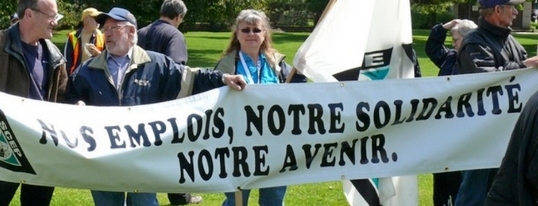
Protest by forestry workers in Ottawa, June 2, 2009, demanding
government take action to defend forestry workers and their communities.
Resolute Forest Products began cutting shifts at seven
sawmills in
Quebec this week and delaying the start of its forest operations. One
thousand two hundred and eighty two workers
will lose their jobs for an indefinite period. Forestry workers and
their small communities are suffering the consequences of an
orchestrated crisis in a sector dominated by huge companies
such as Resolute.
The Quebec forestry industry accounts for 60,000 direct
jobs and
many more indirect ones. In addition to contributing lumber for Quebec
and Canada, the social product is highly
regarded as an export. Ninety per cent of Quebec's softwood lumber
exports go to the United States. Workers in the sector contribute
enormous value to Quebec and Canada. They deserve
respect and peace of mind about their security and future.
La Tuque mayor Normand Beaudoin says Resolute has laid
off 100 mill
workers in his community located about 200 kilometres south of the
Lac-Saint-Jean region. He said any
extended downtime would be difficult not only for the working families
directly affected but the entire town.
Outside Quebec, a small cedar mill in New Brunswick
recently closed
affecting six workers reflecting the growing crisis across Canada and
hardship imposed on workers. Danny
Stillwell, owner of Hainesville Sawmill Ltd., northwest of Fredericton,
said the mill will have to cease operations until the nonsense is over
and he can again sell lumber in the U.S. with
some certainty without having to pay thousands of dollars in duties
before any money is received from the buyer. Mr. Stillwell said his
mill is the major employer in the small town so the
closure "is a very big deal." Lumber from the small Hainesville Sawmill
faces a U.S. duty of 19.88 per cent having been lumped in with all
small sawmills throughout Canada. They also
have to pay the duty immediately and retroactively on all the lumber
they exported to the U.S. back to January 31.
 Lumber from New
Brunswick's J.D. Irving, which has mills
throughout the province and in the U.S., faces a much lower tariff of
3.02 per cent. For the lower tariff, the
self-serving company "voluntarily" argued before the U.S. International
Trade Commission that the timber it mills comes from privately-owned
forest land unlike many mills across Canada,
which pay ground rent or stumpage fees to the state to log Crown-owned
forests. Along with other forestry giants in North America seeking to
raise prices, J.D. Irving implied that certain
competitors, especially in the West, have an "unfair advantage," as
almost all forest land is Crown-owned. The oligarchs at J.D. Irving
will also benefit directly from this crisis with higher
lumber retail prices both in Canada and the U.S. and possible expansion
by taking over the market and even operations of small mills such as
Hainesville Sawmill Ltd. Lumber from New
Brunswick's J.D. Irving, which has mills
throughout the province and in the U.S., faces a much lower tariff of
3.02 per cent. For the lower tariff, the
self-serving company "voluntarily" argued before the U.S. International
Trade Commission that the timber it mills comes from privately-owned
forest land unlike many mills across Canada,
which pay ground rent or stumpage fees to the state to log Crown-owned
forests. Along with other forestry giants in North America seeking to
raise prices, J.D. Irving implied that certain
competitors, especially in the West, have an "unfair advantage," as
almost all forest land is Crown-owned. The oligarchs at J.D. Irving
will also benefit directly from this crisis with higher
lumber retail prices both in Canada and the U.S. and possible expansion
by taking over the market and even operations of small mills such as
Hainesville Sawmill Ltd.
It should be noted that New Brunswick Liberal
Premier Brian
Gallant, a representative of the financial oligarchy in a province
dominated by the Irving Empire, has been quick to
argue against any state aid for small forestry companies and workers
during the current lumber crisis. He contends that the U.S. government
would use that as "further evidence of unfair
subsidies." Gallant has appointed David Wilkins to manage the dispute
on behalf of J.D. Irving's operation and others. Wilkins is the former
U.S. ambassador to Canada during the reign of
President George W. Bush.
Fears exist that this fifth softwood drama concocted by
the
financial oligarchy, which dominates and controls Fortress North
America, could be as punishing as the last one from 2004
to 2006. During that period, Canadian forestry workers lost 20,000 jobs
and 400 sawmills closed. The softwood sector had not even recovered
from that blow when it was hit again with the
collapse of the U.S. housing market in 2008. Once the worst of the
damage of that crisis was thought to be over, the forestry oligarchs
are now using the current upswing in U.S.
construction and increased lumber demand to go after higher prices by
orchestrating another softwood dispute.
The financial oligarchy and the oligopolies it controls
in the
forestry sector throughout Fortress North America are engaged in
constant battles to defend their private interests and
expand their empires, which continually disrupts the sector leading to
economic crises. While falsely presented as a national dispute between
Canada and the U.S. over terms of trade, the
recurring softwood lumber drama in effect has become a regular occasion
to raise retail lumber prices, weaken the forestry workers' organized
defence of their rights, and to consolidate
ownership and control of the sector in the hands of the few.
Calls are becoming louder to put an end to these
recurring crises
that disrupt the lives of so many working people in both Canada and the
United States and seriously harm the
economies of both countries. To bring stability and security to
forestry workers and their communities and to those sectors reliant
upon lumber supply and consistent pricing, a new direction
for the economy free from the self-serving control of the oligopolies
has become the order of the day.

Softwood Lumber Prices Rise Sharply in Canada
Workers' Forum
received a letter and photos from an Ontario construction contractor
showing the sharp rise of softwood lumber prices in Canada. The letter
and comment from Workers' Forum is below.
***
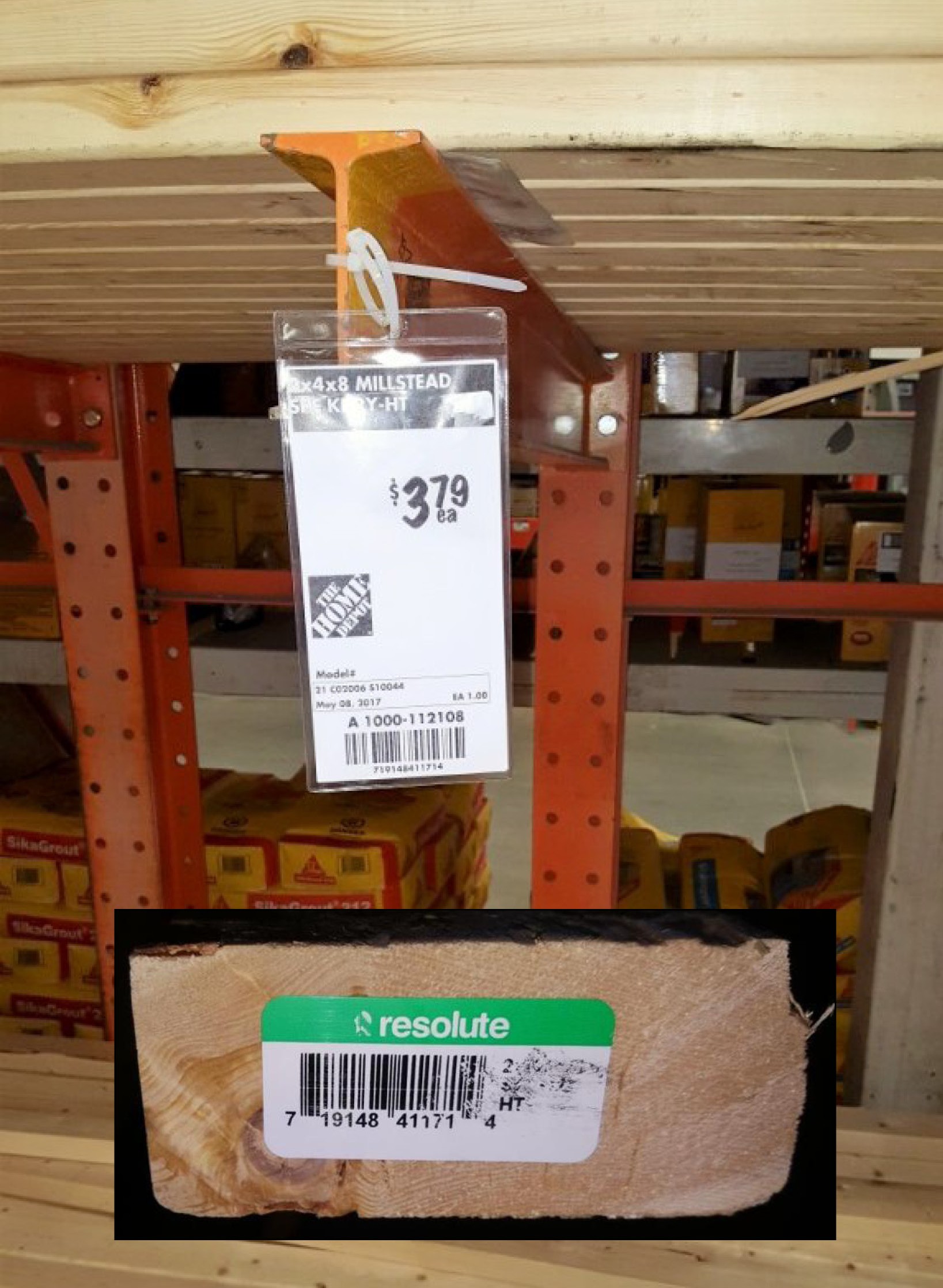 "This size lumber (in photo
-- 2"x4"x8') was $2.59 over the winter. Now, Home Depot
and/or
the suppliers always price gouge come spring
and summer but I have never seen it this high. I am thinking it is
connected to the current scam trade "dispute" and the corresponding
hysteria, which tries to justify price fixing. Weyerhaeuser [the
company at the centre of the recent disputes -- WF note] is the
other supplier at Home Depot. I find it goes back and forth with
Resolute.
Probably whoever gives the better deal for Home Depot at any given
time." "This size lumber (in photo
-- 2"x4"x8') was $2.59 over the winter. Now, Home Depot
and/or
the suppliers always price gouge come spring
and summer but I have never seen it this high. I am thinking it is
connected to the current scam trade "dispute" and the corresponding
hysteria, which tries to justify price fixing. Weyerhaeuser [the
company at the centre of the recent disputes -- WF note] is the
other supplier at Home Depot. I find it goes back and forth with
Resolute.
Probably whoever gives the better deal for Home Depot at any given
time."
Workers' Forum Comment
A 46 per cent price increase for lumber! The U.S.
tariff does not apply to lumber sold in Canada but obviously, that does
not stop the gouging. The big companies must have colluded to apply the
higher U.S. price throughout Fortress North America. The contractor is
correct in denouncing it as a scam.
Resolute's specific softwood lumber tariff
is 12.82 per cent, which is lower than the average of 19.88
per cent most companies are assessed. This means it will pocket any
difference from the tariff and the new higher market prices. Also, it
is one of the four companies that do not have to pay the duty at the
border but only after
selling the lumber and submitting the paperwork.
Weyerhaeuser's assessed tariff is the
average 19.88 per cent but Weyerhaeuser does not have to ship much
lumber to its customers in the U.S., as it is the largest softwood
lumber producer within the United States. Unless of course the specific
wood product is only found in Canada. Weyerhaeuser and other companies
with mills in the
U.S. will greatly benefit from the tariff and higher prices, as they
will pocket the duty as a higher market price.
All the larger lumber companies will benefit from the
higher prices in Canada and from expansion as they seize control of the
small mills that cannot weather the loss of some of their U.S. market,
which has been the case each time the U.S. government has imposed a
higher tariff. In addition, many smaller companies will suffer from
having
to pay the duty upfront and wait for it to be returned with higher
prices when and if the product is sold.
Many construction companies will suffer a loss of
business in both Canada and the U.S., if they cannot find customers
willing to pay a higher price matching the higher price of production
for their construction social product. There could also be some
switching of construction material away from wood.
U.S. furniture manufactures have launched a petition
for exemption from the softwood lumber tariff, as the type of lumber
needed for much of their production is only found in the colder
Canadian climate and they cannot sell furniture with the higher price
of production forced upon them with the tariff.
Resolute may not profit as much as the other big
companies in the Canadian forestry sector because at this point it does
not have any U.S. lumber mills. In addition, Resolute's Canadian mills
are in Quebec and Ontario where the ground rent for forest use is
higher than in BC. The big lumber companies in BC with mills in the U.S
can supply
most of their U.S. lumber customers from their U.S. mills, especially
as demand may drop off somewhat with these kinds of large price
increases. They can also ship BC raw logs to their own U.S. mills and
then cut them into lumber circumventing the tariff. Raw softwood logs
are not subject to the duty.
Resolute and other producers in Canada are also
threatened with the countervailing duty (accused of selling social
product in the U.S. below the price of production) to be applied later
this year on top of the tariff. The extra duty will then put even more
upward pressure on lumber prices through North America.
The 46 per cent jump in the price of lumber at
Home Depot in Canada shows how susceptible the economy is to
manipulation by the financial oligarchy and how destructive this
manipulation can be for the economies of both the U.S. and Canada. The
time has come to remove the power of the oligopolies from the economy
and march
forward in a new pro-social direction under the control of the actual
producers, the working class, and their allies.

PREVIOUS
ISSUES | HOME
Website: www.cpcml.ca
Email: office@cpcml.ca
|

